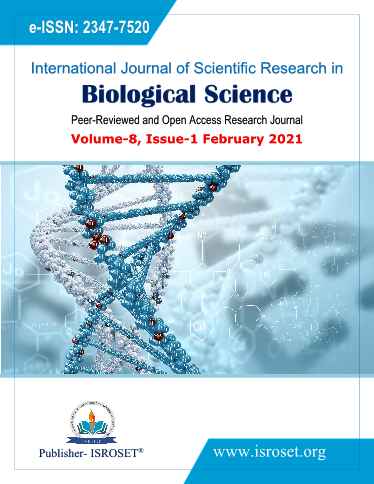Characterization and Identification of Fungal Species Associated with the Spoilage of Cocoyam (Colocasia esculenta L.) in Gwandu Local Government Area, Kebbi State, Nigeria
Keywords:
Fungi, cocoyam, load, GwanduAbstract
fungal species are paramount important causal agent responsible for the spoilage of Cocoyam. Samples of cocoyam were obtained in Gotomo village of Gwandu local government, Kebbi State, Nigeria. Three (3) villages were selected for sample collections within the L.G.A namely; Rafin raggaye, Shiyar gobirawa and Garba gibbar. A total of Sixty (60) tubers of Colocasia esculenta L. were collected, from each points Twenty (20) samples of Colocasia esculenta tubers were collected. Pour plate method was used in the enumeration of potential spoilage fungi in cocoyam samples. From the results obtained a total number of seven (7) fungal species were isolated and identified namely; Aspergillus niger, Mucor racemosus, Aspergillus flavus, Fusarium oxysporium, Rhizopus stolonifer, Rhizopus oryzae and Penicillium expansum. The most prevalent fungal isolate was Aspergillus flavus 32.5% and Penicillium species was the least prevalent among the isolates with 5%. The mean fungal spore count (sfu/ml) showed that cocoyam obtained from Shiyar gobirawa had the highest fungal load 4.3 x 106 and the lowest was recorded in Rafin raggaye 12 x 104. These fungal species isolated in this research were said to be pathogenic that cause the spoilage of Colocasia esculenta and hence their presence on cocoyam may be additional reservoirs for the transmission of pathogenic microorganisms and this could results to infections for consumers and economic loss. This raise concern over public health risks that may be associated with the consumption of deteriorated cocoyam and proper storage, package and handling methods with good transportation should be taken to reduce the occurrence and deterioration of cocoyam by these microbes.
References
B, Deni, Aroids plants of the arum family. Timber press, Portland. pp. 201-215, 2000.
M. Charles, The Tropical Tuber Crops: Yams, Cassava, Sweet Potato and Cocoyams. Wiley, New York, p. 210, 1992
T. Melese, R. Negussie, Nutritional potential, health and food security benefits of taro Colocasia esculenta (L.): A review. Food Science and Quality Management, Vol. 36, pp. 23-30, 2015.
L.T. Ogunniyi, Profit Efficiency among Cocoyam Producers in Osun State, Nigeria. International Journal of food marketing. Vol. 3 Issue 2 pp. 45-51, 2008.
V.R. Rao, D. Hunter, P.B. Eyzaguirre, P.J. Matthews, Ethno-botany and global diversity of taro. In: Rao RV, Matthews PJ, Eyzaguirre PB, Hunter D, eds. The Global Diversity of Taro Ethno-botany and Conservation. Biodiversity International, Rome, Italy. pp. 1-5, 2010.
I.A. Onoharigho, A.A. Ogunjobi, The Activities of Rhizosphere Bacteria in Improving the Growth of Habanero Pepper (Capsicum chinense Jacq.) and Soil Fertility. International Journal of Scientific Research in Biological Sciences. Vol.7, Issue.6, pp.113-119, 2020.
FAO. Food crop and storage. Corporate Document Repository and Database. Rome: Food and Agricultural Organization. 2006.
J.N. Keta, and A, Mubarak, Proximate Composition and Growth Performance of Cassava peels Fermented with Microbial Isolates on Cockerel (Gallus domesticus). Un-publishing Dissertation. pp. 24-26, 2020
D. Rees, Q.E.A. van Oirschot, R. Amour, E. Rwiza, R. Kapinga, T. Carey, Cultivation variation in keeping quality of sweet potatoes. Post-harvest spoilage. Technology, Vol. 28, pp. 313-325, 2003.
A. Khatoon, A. Mohapatra, K.B. Satapathy, Fungi Associated with Storage Rots of Colocasia esculenta L. Tubers in Bhubaneswar City, Odisha. British Microbiology Research Journal, Vol. 12, Issue 3, pp. 1-5, 2016.
K.C. Agu, N.S. Awah, A.C. Nnadozie, B.C. Okeke, M.U. Orji, C.A. C.G. Iloanusi Anaukwu, H.C. Eneite, M.C. Ifediegwu, N.D. Umeoduagu, E.E. Udoh, Isolation, Identification and Pathogenicity of Fungi Associated with Cocoyam (Colocasia esculenta) Spoilage. Food Science and Technology, Vol. 4, Issue 5, pp. 103-106, 2016.
U. Chimeriri, M.O. Udo, The life and people of Aliero. Published by Pyla Mark, Nigerian LTD. pp. 34-39, 2006.
M, Cheesbrough, Laboratory Preparation of Media. Clinical Science, Vol. 26. pp. 781-805, 2008
M, Cheesbrough, District Laboratory Practice in Tropical countries. Low price edition. Cambridge University Press. pp: 314-337, 2000.
S.B. Oyeleke, S.B. Manga, Essential of laboratory practical in microbiology to best publisher Minna, Nigeria. pp. 36-75, 2008.
S.D. Ibrahim, Fungal pathogens Associated with Stored Onions in Maiduguri and Bama Towns of Borno state. Unpublished M.Sc. thesis, University of Maiduguri. pp. 35-40, 2005.
T.L. Joon, W.B. Don, H.P. Seun, K.S. Chang, S.K. Youn, K.K. Hee, Occurrence and Biological Control of Postharvest Decay in Onion Caused by Fungi. Plant Pathology Journal, Vol. 17, Issue 3, pp. 141-148, 2001.
A. Snowdon, A Color Atlas of Post-harvest Diseases and Disorders of Fruits and Vegetables Vol. 1 Wolfe Scientific Ltd. London. p. 302, 1991.
C.A. Clark, C. Moyer, Compendium of sweet potato disease. Phytopathology, Vol. 3: pp. 70-74, 1988.
R.N. Okigbo, Fungi Associated with Peels of Post-Harvest Yam in storage. Global Journal of Pure and Applied Science, Vol. 9, pp. 19-23, 2003.
Downloads
Published
How to Cite
Issue
Section
License

This work is licensed under a Creative Commons Attribution 4.0 International License.
Authors contributing to this journal agree to publish their articles under the Creative Commons Attribution 4.0 International License, allowing third parties to share their work (copy, distribute, transmit) and to adapt it, under the condition that the authors are given credit and that in the event of reuse or distribution, the terms of this license are made clear.







